Personal Leadership Development Plan Report - CSU, Autumn 2018
VerifiedAdded on 2023/06/04
|19
|4024
|402
Report
AI Summary
This report details a student's Personal Leadership Development Plan (PLDP), developed through self-insight quizzes focusing on leadership orientation, style, and role. The student identified strengths in structure, problem-solving, and vision, while recognizing weaknesses in interpersonal skills and inexperience. The plan outlines a vision of honesty, confidence, and commitment, with objectives centered on building trust, increasing productivity, and developing leadership skills. Actions to achieve these objectives include open communication, delegation, and continuous self-assessment. The student emphasizes the importance of feedback from mentors and peers, with a strategy for annual and quarterly plan reviews to ensure progress and incorporate improvements. The report concludes with recommendations for enhanced stakeholder communication and team collaboration.
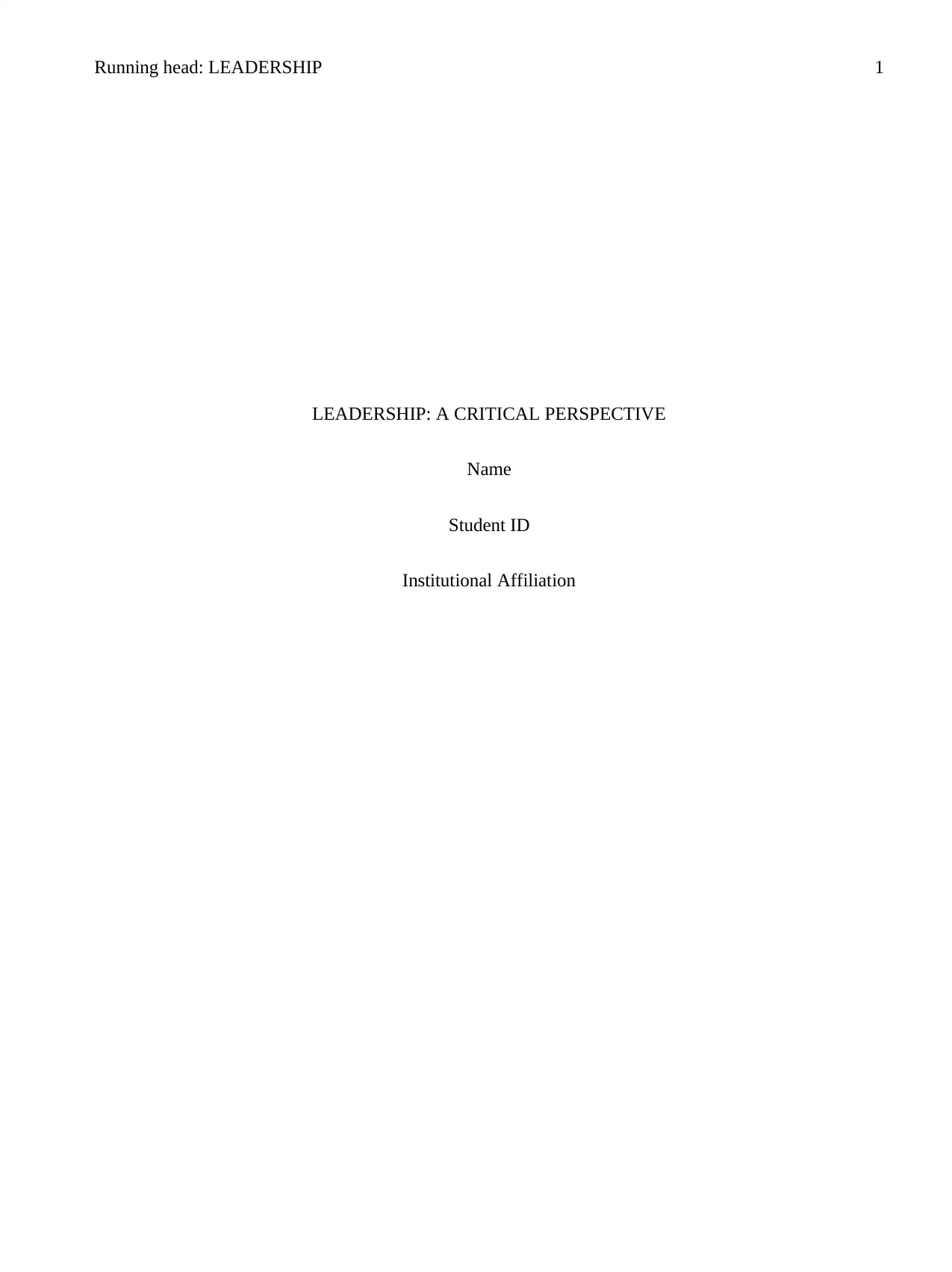
Running head: LEADERSHIP 1
LEADERSHIP: A CRITICAL PERSPECTIVE
Name
Student ID
Institutional Affiliation
LEADERSHIP: A CRITICAL PERSPECTIVE
Name
Student ID
Institutional Affiliation
Paraphrase This Document
Need a fresh take? Get an instant paraphrase of this document with our AI Paraphraser
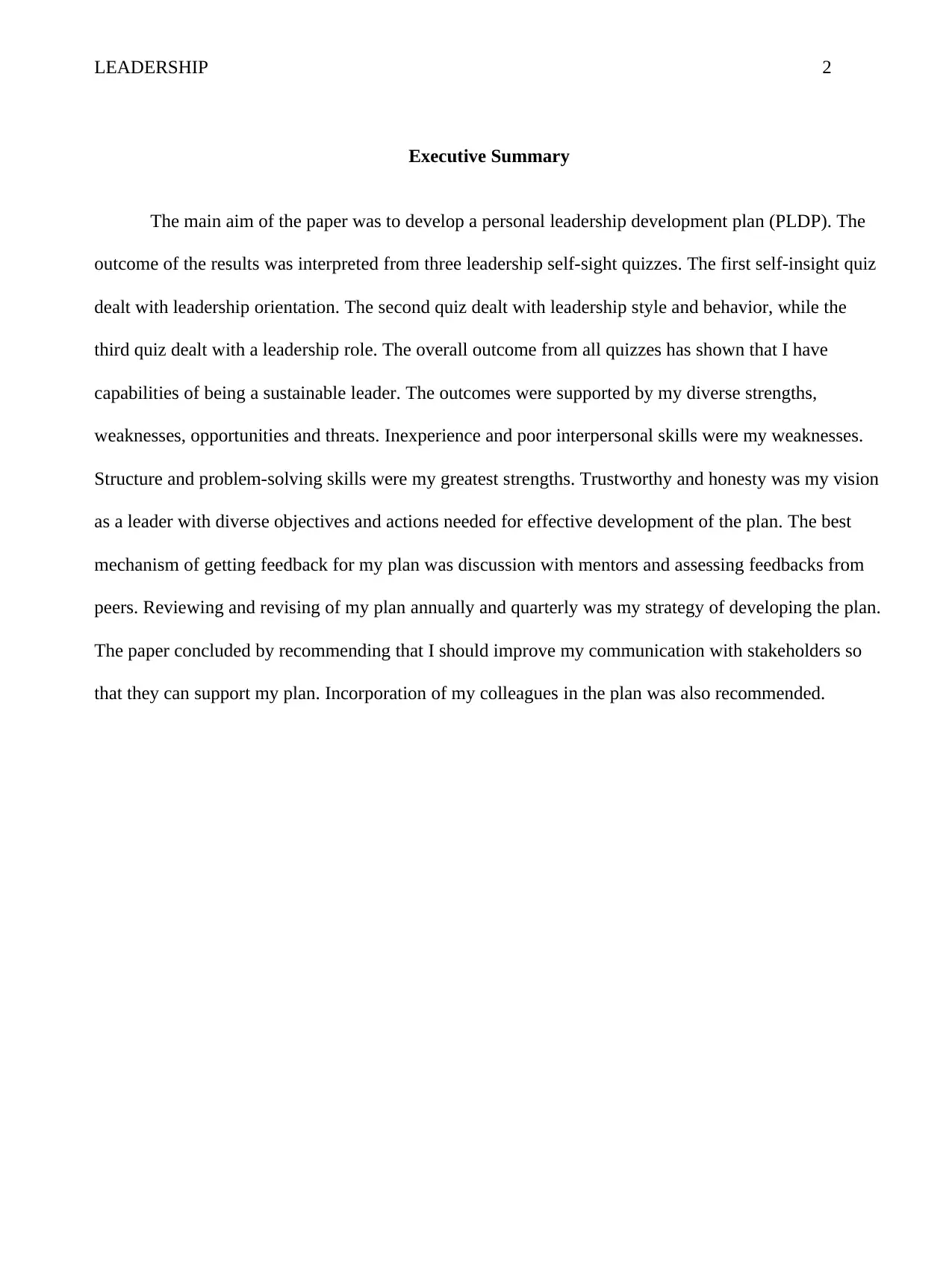
LEADERSHIP 2
Executive Summary
The main aim of the paper was to develop a personal leadership development plan (PLDP). The
outcome of the results was interpreted from three leadership self-sight quizzes. The first self-insight quiz
dealt with leadership orientation. The second quiz dealt with leadership style and behavior, while the
third quiz dealt with a leadership role. The overall outcome from all quizzes has shown that I have
capabilities of being a sustainable leader. The outcomes were supported by my diverse strengths,
weaknesses, opportunities and threats. Inexperience and poor interpersonal skills were my weaknesses.
Structure and problem-solving skills were my greatest strengths. Trustworthy and honesty was my vision
as a leader with diverse objectives and actions needed for effective development of the plan. The best
mechanism of getting feedback for my plan was discussion with mentors and assessing feedbacks from
peers. Reviewing and revising of my plan annually and quarterly was my strategy of developing the plan.
The paper concluded by recommending that I should improve my communication with stakeholders so
that they can support my plan. Incorporation of my colleagues in the plan was also recommended.
Executive Summary
The main aim of the paper was to develop a personal leadership development plan (PLDP). The
outcome of the results was interpreted from three leadership self-sight quizzes. The first self-insight quiz
dealt with leadership orientation. The second quiz dealt with leadership style and behavior, while the
third quiz dealt with a leadership role. The overall outcome from all quizzes has shown that I have
capabilities of being a sustainable leader. The outcomes were supported by my diverse strengths,
weaknesses, opportunities and threats. Inexperience and poor interpersonal skills were my weaknesses.
Structure and problem-solving skills were my greatest strengths. Trustworthy and honesty was my vision
as a leader with diverse objectives and actions needed for effective development of the plan. The best
mechanism of getting feedback for my plan was discussion with mentors and assessing feedbacks from
peers. Reviewing and revising of my plan annually and quarterly was my strategy of developing the plan.
The paper concluded by recommending that I should improve my communication with stakeholders so
that they can support my plan. Incorporation of my colleagues in the plan was also recommended.
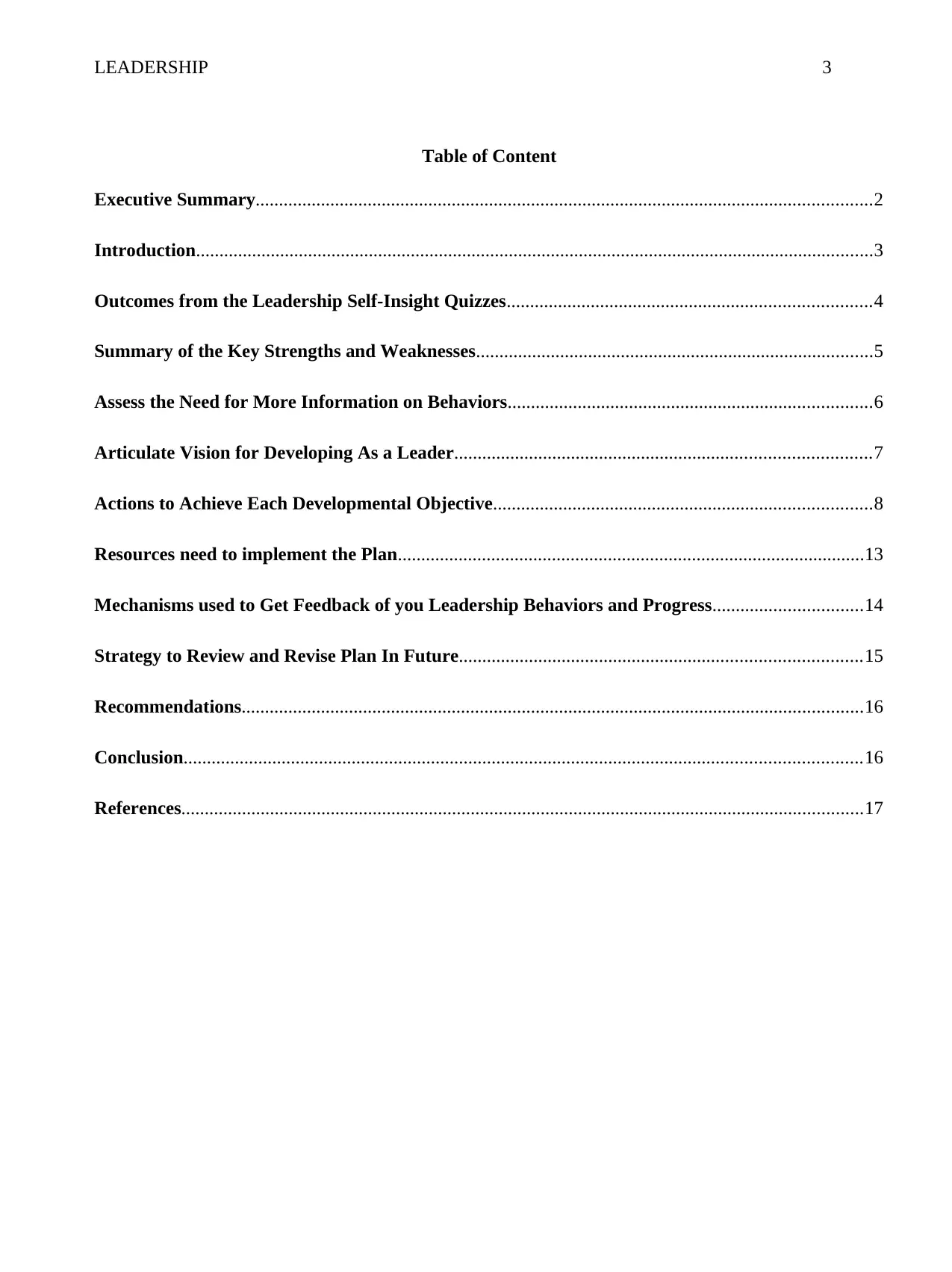
LEADERSHIP 3
Table of Content
Executive Summary....................................................................................................................................2
Introduction.................................................................................................................................................3
Outcomes from the Leadership Self-Insight Quizzes..............................................................................4
Summary of the Key Strengths and Weaknesses.....................................................................................5
Assess the Need for More Information on Behaviors..............................................................................6
Articulate Vision for Developing As a Leader.........................................................................................7
Actions to Achieve Each Developmental Objective.................................................................................8
Resources need to implement the Plan....................................................................................................13
Mechanisms used to Get Feedback of you Leadership Behaviors and Progress................................14
Strategy to Review and Revise Plan In Future......................................................................................15
Recommendations.....................................................................................................................................16
Conclusion.................................................................................................................................................16
References..................................................................................................................................................17
Table of Content
Executive Summary....................................................................................................................................2
Introduction.................................................................................................................................................3
Outcomes from the Leadership Self-Insight Quizzes..............................................................................4
Summary of the Key Strengths and Weaknesses.....................................................................................5
Assess the Need for More Information on Behaviors..............................................................................6
Articulate Vision for Developing As a Leader.........................................................................................7
Actions to Achieve Each Developmental Objective.................................................................................8
Resources need to implement the Plan....................................................................................................13
Mechanisms used to Get Feedback of you Leadership Behaviors and Progress................................14
Strategy to Review and Revise Plan In Future......................................................................................15
Recommendations.....................................................................................................................................16
Conclusion.................................................................................................................................................16
References..................................................................................................................................................17
⊘ This is a preview!⊘
Do you want full access?
Subscribe today to unlock all pages.

Trusted by 1+ million students worldwide
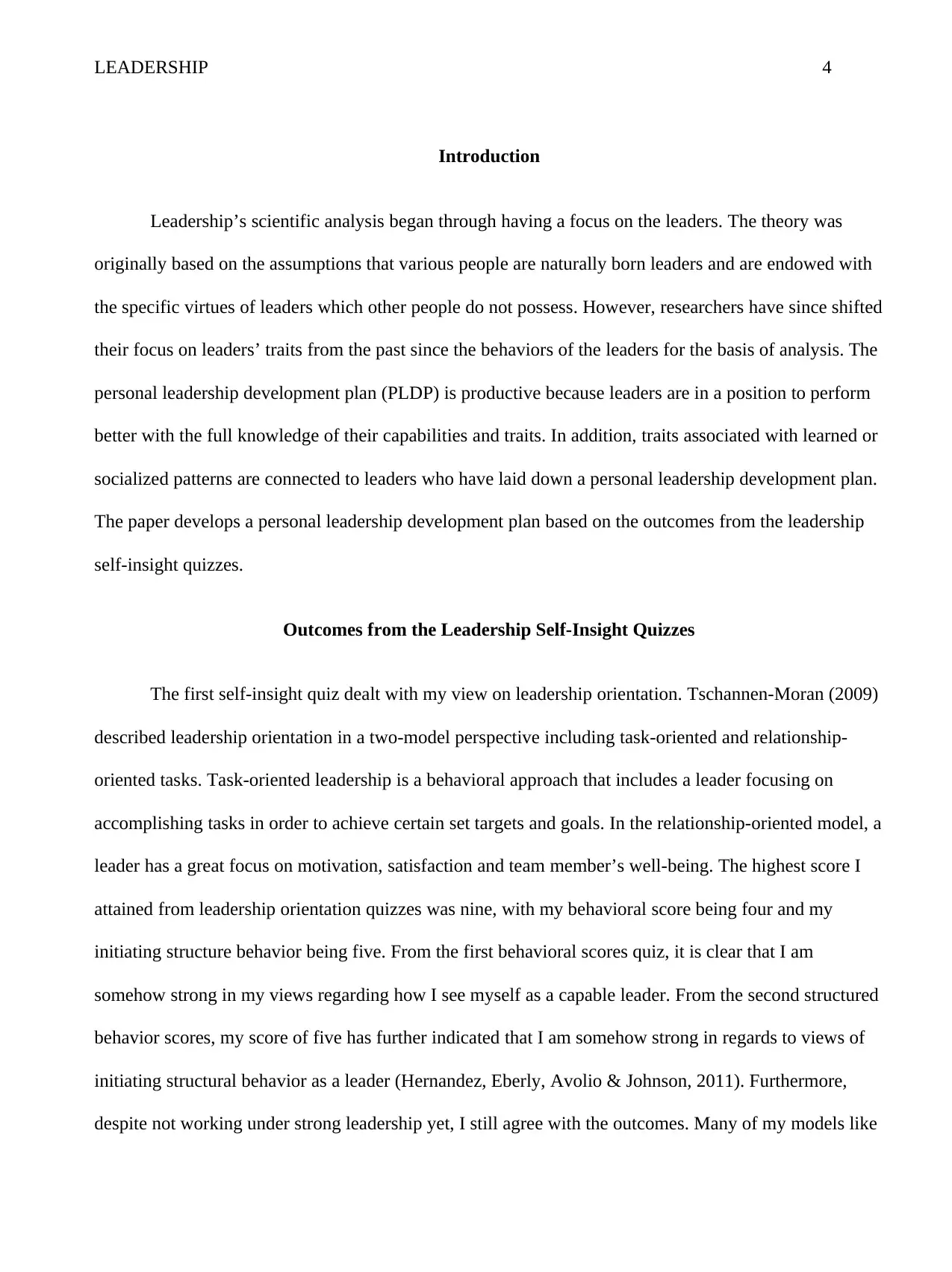
LEADERSHIP 4
Introduction
Leadership’s scientific analysis began through having a focus on the leaders. The theory was
originally based on the assumptions that various people are naturally born leaders and are endowed with
the specific virtues of leaders which other people do not possess. However, researchers have since shifted
their focus on leaders’ traits from the past since the behaviors of the leaders for the basis of analysis. The
personal leadership development plan (PLDP) is productive because leaders are in a position to perform
better with the full knowledge of their capabilities and traits. In addition, traits associated with learned or
socialized patterns are connected to leaders who have laid down a personal leadership development plan.
The paper develops a personal leadership development plan based on the outcomes from the leadership
self-insight quizzes.
Outcomes from the Leadership Self-Insight Quizzes
The first self-insight quiz dealt with my view on leadership orientation. Tschannen-Moran (2009)
described leadership orientation in a two-model perspective including task-oriented and relationship-
oriented tasks. Task-oriented leadership is a behavioral approach that includes a leader focusing on
accomplishing tasks in order to achieve certain set targets and goals. In the relationship-oriented model, a
leader has a great focus on motivation, satisfaction and team member’s well-being. The highest score I
attained from leadership orientation quizzes was nine, with my behavioral score being four and my
initiating structure behavior being five. From the first behavioral scores quiz, it is clear that I am
somehow strong in my views regarding how I see myself as a capable leader. From the second structured
behavior scores, my score of five has further indicated that I am somehow strong in regards to views of
initiating structural behavior as a leader (Hernandez, Eberly, Avolio & Johnson, 2011). Furthermore,
despite not working under strong leadership yet, I still agree with the outcomes. Many of my models like
Introduction
Leadership’s scientific analysis began through having a focus on the leaders. The theory was
originally based on the assumptions that various people are naturally born leaders and are endowed with
the specific virtues of leaders which other people do not possess. However, researchers have since shifted
their focus on leaders’ traits from the past since the behaviors of the leaders for the basis of analysis. The
personal leadership development plan (PLDP) is productive because leaders are in a position to perform
better with the full knowledge of their capabilities and traits. In addition, traits associated with learned or
socialized patterns are connected to leaders who have laid down a personal leadership development plan.
The paper develops a personal leadership development plan based on the outcomes from the leadership
self-insight quizzes.
Outcomes from the Leadership Self-Insight Quizzes
The first self-insight quiz dealt with my view on leadership orientation. Tschannen-Moran (2009)
described leadership orientation in a two-model perspective including task-oriented and relationship-
oriented tasks. Task-oriented leadership is a behavioral approach that includes a leader focusing on
accomplishing tasks in order to achieve certain set targets and goals. In the relationship-oriented model, a
leader has a great focus on motivation, satisfaction and team member’s well-being. The highest score I
attained from leadership orientation quizzes was nine, with my behavioral score being four and my
initiating structure behavior being five. From the first behavioral scores quiz, it is clear that I am
somehow strong in my views regarding how I see myself as a capable leader. From the second structured
behavior scores, my score of five has further indicated that I am somehow strong in regards to views of
initiating structural behavior as a leader (Hernandez, Eberly, Avolio & Johnson, 2011). Furthermore,
despite not working under strong leadership yet, I still agree with the outcomes. Many of my models like
Paraphrase This Document
Need a fresh take? Get an instant paraphrase of this document with our AI Paraphraser
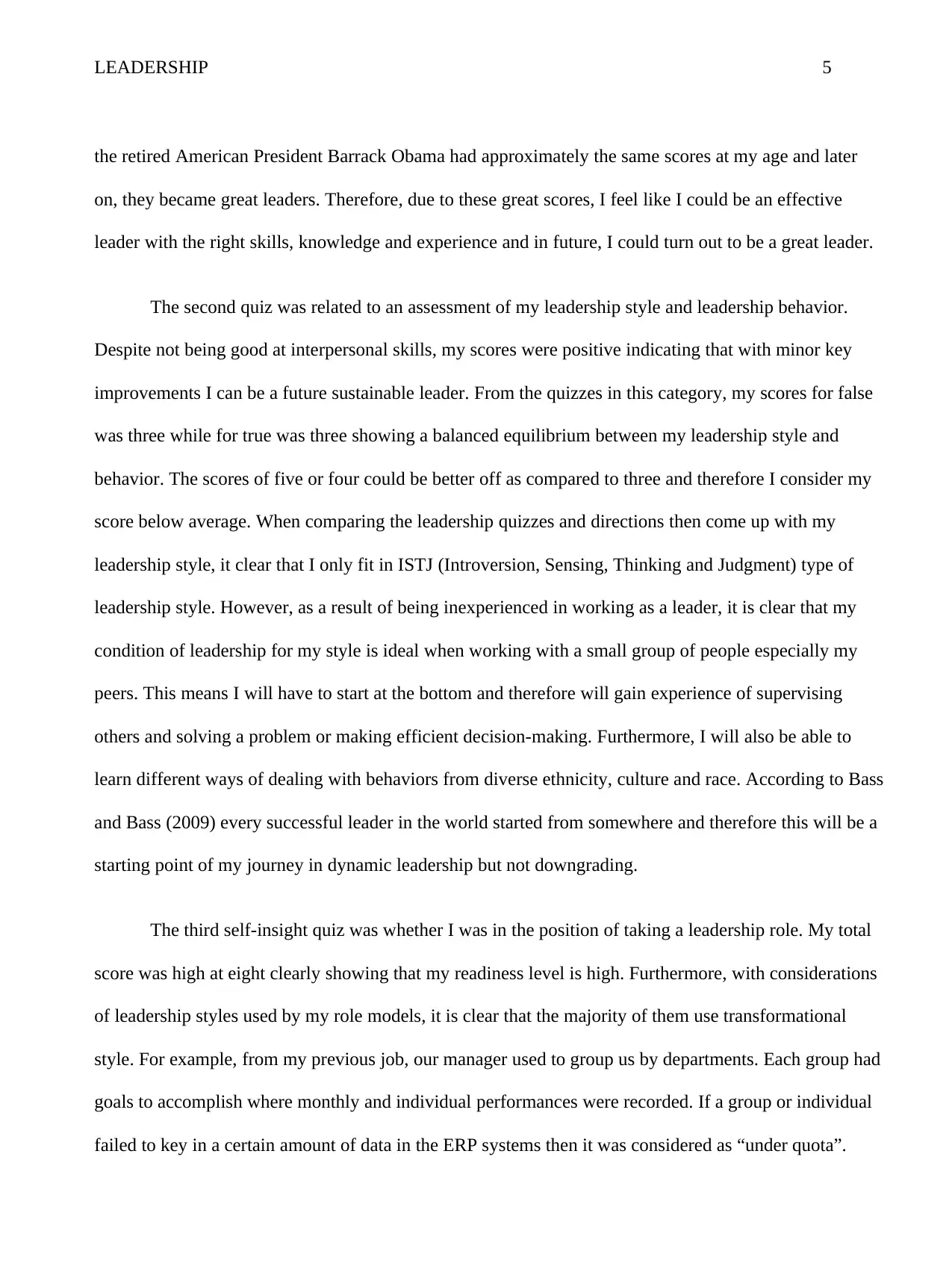
LEADERSHIP 5
the retired American President Barrack Obama had approximately the same scores at my age and later
on, they became great leaders. Therefore, due to these great scores, I feel like I could be an effective
leader with the right skills, knowledge and experience and in future, I could turn out to be a great leader.
The second quiz was related to an assessment of my leadership style and leadership behavior.
Despite not being good at interpersonal skills, my scores were positive indicating that with minor key
improvements I can be a future sustainable leader. From the quizzes in this category, my scores for false
was three while for true was three showing a balanced equilibrium between my leadership style and
behavior. The scores of five or four could be better off as compared to three and therefore I consider my
score below average. When comparing the leadership quizzes and directions then come up with my
leadership style, it clear that I only fit in ISTJ (Introversion, Sensing, Thinking and Judgment) type of
leadership style. However, as a result of being inexperienced in working as a leader, it is clear that my
condition of leadership for my style is ideal when working with a small group of people especially my
peers. This means I will have to start at the bottom and therefore will gain experience of supervising
others and solving a problem or making efficient decision-making. Furthermore, I will also be able to
learn different ways of dealing with behaviors from diverse ethnicity, culture and race. According to Bass
and Bass (2009) every successful leader in the world started from somewhere and therefore this will be a
starting point of my journey in dynamic leadership but not downgrading.
The third self-insight quiz was whether I was in the position of taking a leadership role. My total
score was high at eight clearly showing that my readiness level is high. Furthermore, with considerations
of leadership styles used by my role models, it is clear that the majority of them use transformational
style. For example, from my previous job, our manager used to group us by departments. Each group had
goals to accomplish where monthly and individual performances were recorded. If a group or individual
failed to key in a certain amount of data in the ERP systems then it was considered as “under quota”.
the retired American President Barrack Obama had approximately the same scores at my age and later
on, they became great leaders. Therefore, due to these great scores, I feel like I could be an effective
leader with the right skills, knowledge and experience and in future, I could turn out to be a great leader.
The second quiz was related to an assessment of my leadership style and leadership behavior.
Despite not being good at interpersonal skills, my scores were positive indicating that with minor key
improvements I can be a future sustainable leader. From the quizzes in this category, my scores for false
was three while for true was three showing a balanced equilibrium between my leadership style and
behavior. The scores of five or four could be better off as compared to three and therefore I consider my
score below average. When comparing the leadership quizzes and directions then come up with my
leadership style, it clear that I only fit in ISTJ (Introversion, Sensing, Thinking and Judgment) type of
leadership style. However, as a result of being inexperienced in working as a leader, it is clear that my
condition of leadership for my style is ideal when working with a small group of people especially my
peers. This means I will have to start at the bottom and therefore will gain experience of supervising
others and solving a problem or making efficient decision-making. Furthermore, I will also be able to
learn different ways of dealing with behaviors from diverse ethnicity, culture and race. According to Bass
and Bass (2009) every successful leader in the world started from somewhere and therefore this will be a
starting point of my journey in dynamic leadership but not downgrading.
The third self-insight quiz was whether I was in the position of taking a leadership role. My total
score was high at eight clearly showing that my readiness level is high. Furthermore, with considerations
of leadership styles used by my role models, it is clear that the majority of them use transformational
style. For example, from my previous job, our manager used to group us by departments. Each group had
goals to accomplish where monthly and individual performances were recorded. If a group or individual
failed to key in a certain amount of data in the ERP systems then it was considered as “under quota”.
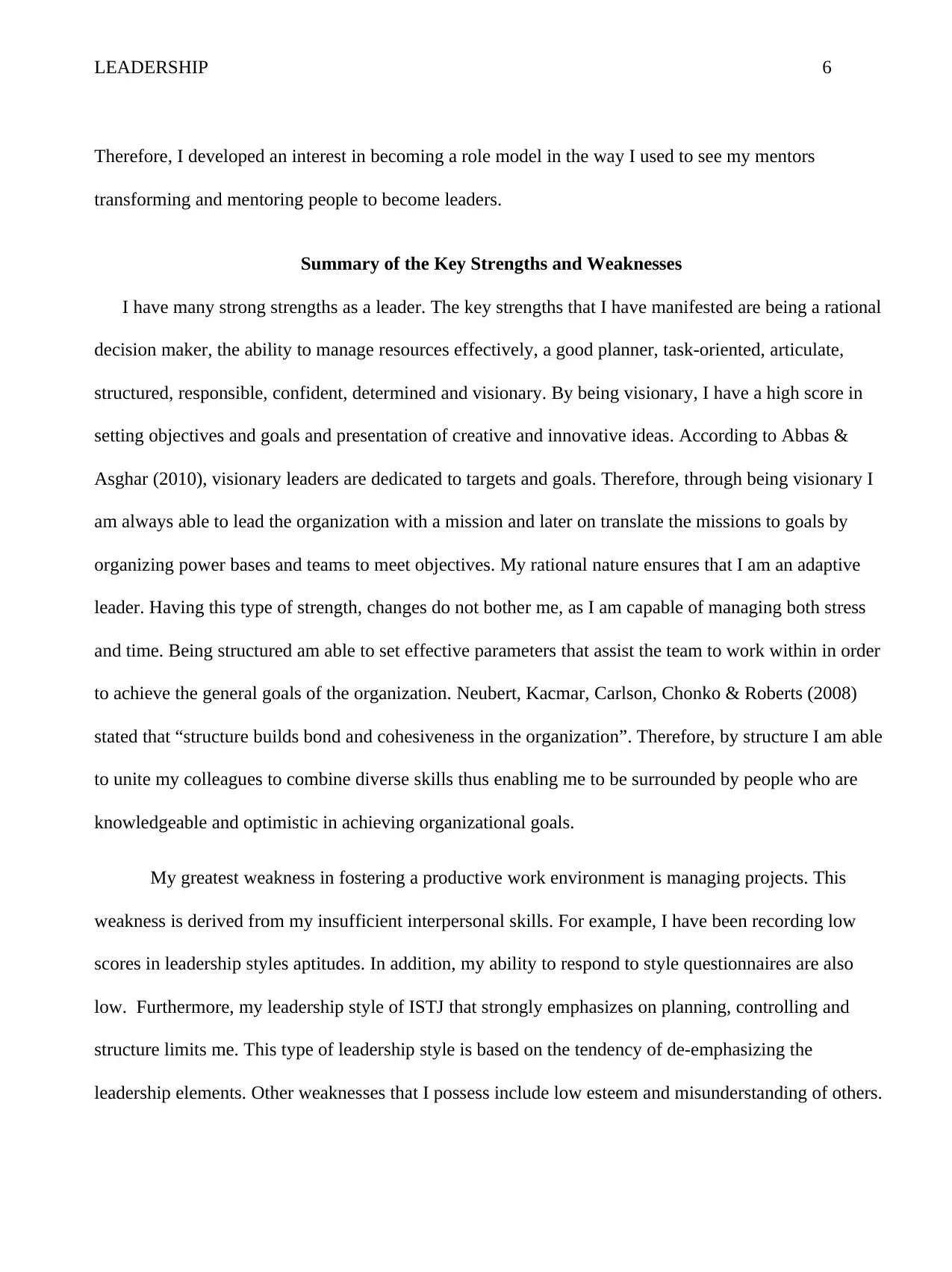
LEADERSHIP 6
Therefore, I developed an interest in becoming a role model in the way I used to see my mentors
transforming and mentoring people to become leaders.
Summary of the Key Strengths and Weaknesses
I have many strong strengths as a leader. The key strengths that I have manifested are being a rational
decision maker, the ability to manage resources effectively, a good planner, task-oriented, articulate,
structured, responsible, confident, determined and visionary. By being visionary, I have a high score in
setting objectives and goals and presentation of creative and innovative ideas. According to Abbas &
Asghar (2010), visionary leaders are dedicated to targets and goals. Therefore, through being visionary I
am always able to lead the organization with a mission and later on translate the missions to goals by
organizing power bases and teams to meet objectives. My rational nature ensures that I am an adaptive
leader. Having this type of strength, changes do not bother me, as I am capable of managing both stress
and time. Being structured am able to set effective parameters that assist the team to work within in order
to achieve the general goals of the organization. Neubert, Kacmar, Carlson, Chonko & Roberts (2008)
stated that “structure builds bond and cohesiveness in the organization”. Therefore, by structure I am able
to unite my colleagues to combine diverse skills thus enabling me to be surrounded by people who are
knowledgeable and optimistic in achieving organizational goals.
My greatest weakness in fostering a productive work environment is managing projects. This
weakness is derived from my insufficient interpersonal skills. For example, I have been recording low
scores in leadership styles aptitudes. In addition, my ability to respond to style questionnaires are also
low. Furthermore, my leadership style of ISTJ that strongly emphasizes on planning, controlling and
structure limits me. This type of leadership style is based on the tendency of de-emphasizing the
leadership elements. Other weaknesses that I possess include low esteem and misunderstanding of others.
Therefore, I developed an interest in becoming a role model in the way I used to see my mentors
transforming and mentoring people to become leaders.
Summary of the Key Strengths and Weaknesses
I have many strong strengths as a leader. The key strengths that I have manifested are being a rational
decision maker, the ability to manage resources effectively, a good planner, task-oriented, articulate,
structured, responsible, confident, determined and visionary. By being visionary, I have a high score in
setting objectives and goals and presentation of creative and innovative ideas. According to Abbas &
Asghar (2010), visionary leaders are dedicated to targets and goals. Therefore, through being visionary I
am always able to lead the organization with a mission and later on translate the missions to goals by
organizing power bases and teams to meet objectives. My rational nature ensures that I am an adaptive
leader. Having this type of strength, changes do not bother me, as I am capable of managing both stress
and time. Being structured am able to set effective parameters that assist the team to work within in order
to achieve the general goals of the organization. Neubert, Kacmar, Carlson, Chonko & Roberts (2008)
stated that “structure builds bond and cohesiveness in the organization”. Therefore, by structure I am able
to unite my colleagues to combine diverse skills thus enabling me to be surrounded by people who are
knowledgeable and optimistic in achieving organizational goals.
My greatest weakness in fostering a productive work environment is managing projects. This
weakness is derived from my insufficient interpersonal skills. For example, I have been recording low
scores in leadership styles aptitudes. In addition, my ability to respond to style questionnaires are also
low. Furthermore, my leadership style of ISTJ that strongly emphasizes on planning, controlling and
structure limits me. This type of leadership style is based on the tendency of de-emphasizing the
leadership elements. Other weaknesses that I possess include low esteem and misunderstanding of others.
⊘ This is a preview!⊘
Do you want full access?
Subscribe today to unlock all pages.

Trusted by 1+ million students worldwide
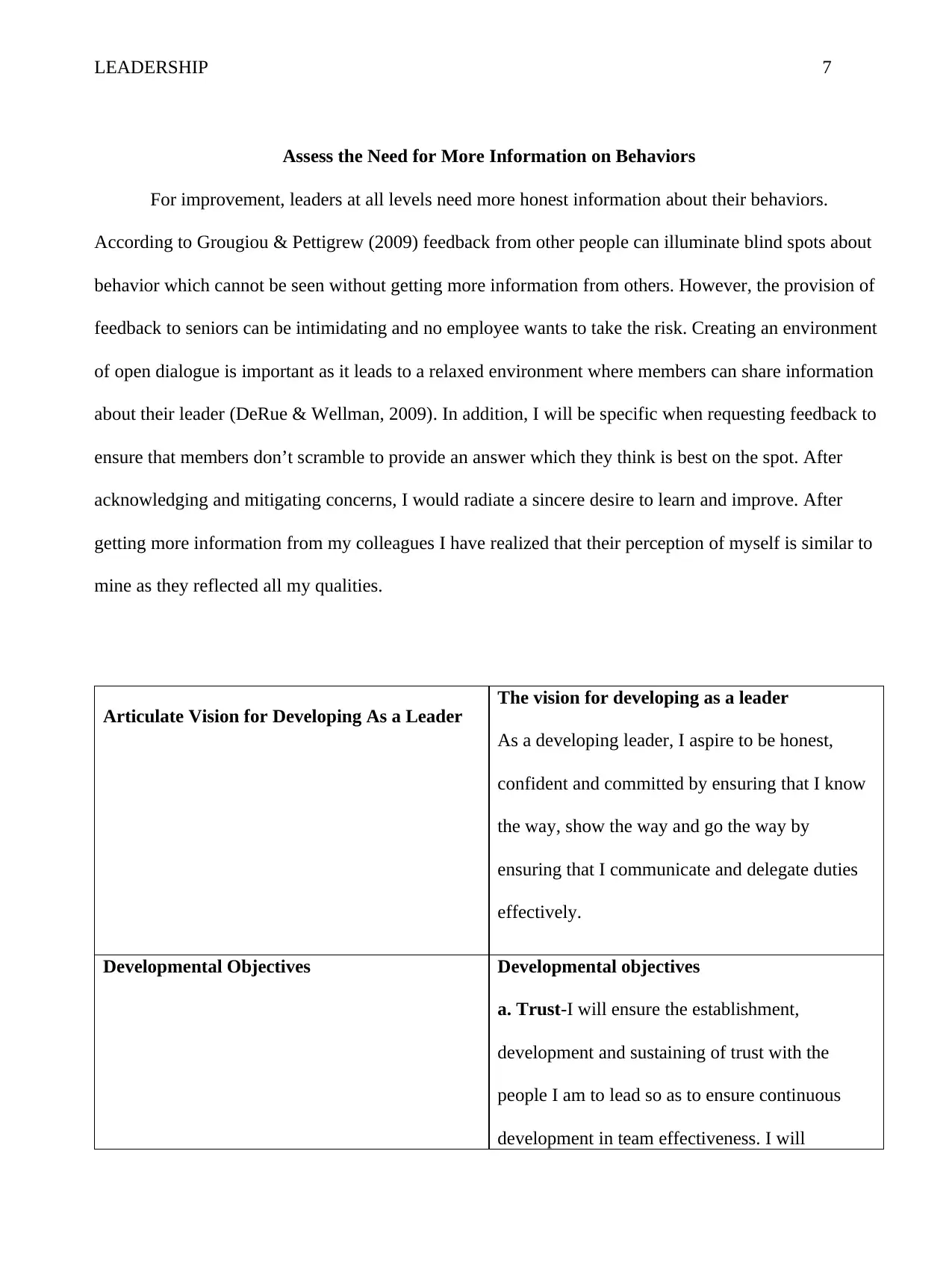
LEADERSHIP 7
Assess the Need for More Information on Behaviors
For improvement, leaders at all levels need more honest information about their behaviors.
According to Grougiou & Pettigrew (2009) feedback from other people can illuminate blind spots about
behavior which cannot be seen without getting more information from others. However, the provision of
feedback to seniors can be intimidating and no employee wants to take the risk. Creating an environment
of open dialogue is important as it leads to a relaxed environment where members can share information
about their leader (DeRue & Wellman, 2009). In addition, I will be specific when requesting feedback to
ensure that members don’t scramble to provide an answer which they think is best on the spot. After
acknowledging and mitigating concerns, I would radiate a sincere desire to learn and improve. After
getting more information from my colleagues I have realized that their perception of myself is similar to
mine as they reflected all my qualities.
Articulate Vision for Developing As a Leader The vision for developing as a leader
As a developing leader, I aspire to be honest,
confident and committed by ensuring that I know
the way, show the way and go the way by
ensuring that I communicate and delegate duties
effectively.
Developmental Objectives Developmental objectives
a. Trust-I will ensure the establishment,
development and sustaining of trust with the
people I am to lead so as to ensure continuous
development in team effectiveness. I will
Assess the Need for More Information on Behaviors
For improvement, leaders at all levels need more honest information about their behaviors.
According to Grougiou & Pettigrew (2009) feedback from other people can illuminate blind spots about
behavior which cannot be seen without getting more information from others. However, the provision of
feedback to seniors can be intimidating and no employee wants to take the risk. Creating an environment
of open dialogue is important as it leads to a relaxed environment where members can share information
about their leader (DeRue & Wellman, 2009). In addition, I will be specific when requesting feedback to
ensure that members don’t scramble to provide an answer which they think is best on the spot. After
acknowledging and mitigating concerns, I would radiate a sincere desire to learn and improve. After
getting more information from my colleagues I have realized that their perception of myself is similar to
mine as they reflected all my qualities.
Articulate Vision for Developing As a Leader The vision for developing as a leader
As a developing leader, I aspire to be honest,
confident and committed by ensuring that I know
the way, show the way and go the way by
ensuring that I communicate and delegate duties
effectively.
Developmental Objectives Developmental objectives
a. Trust-I will ensure the establishment,
development and sustaining of trust with the
people I am to lead so as to ensure continuous
development in team effectiveness. I will
Paraphrase This Document
Need a fresh take? Get an instant paraphrase of this document with our AI Paraphraser
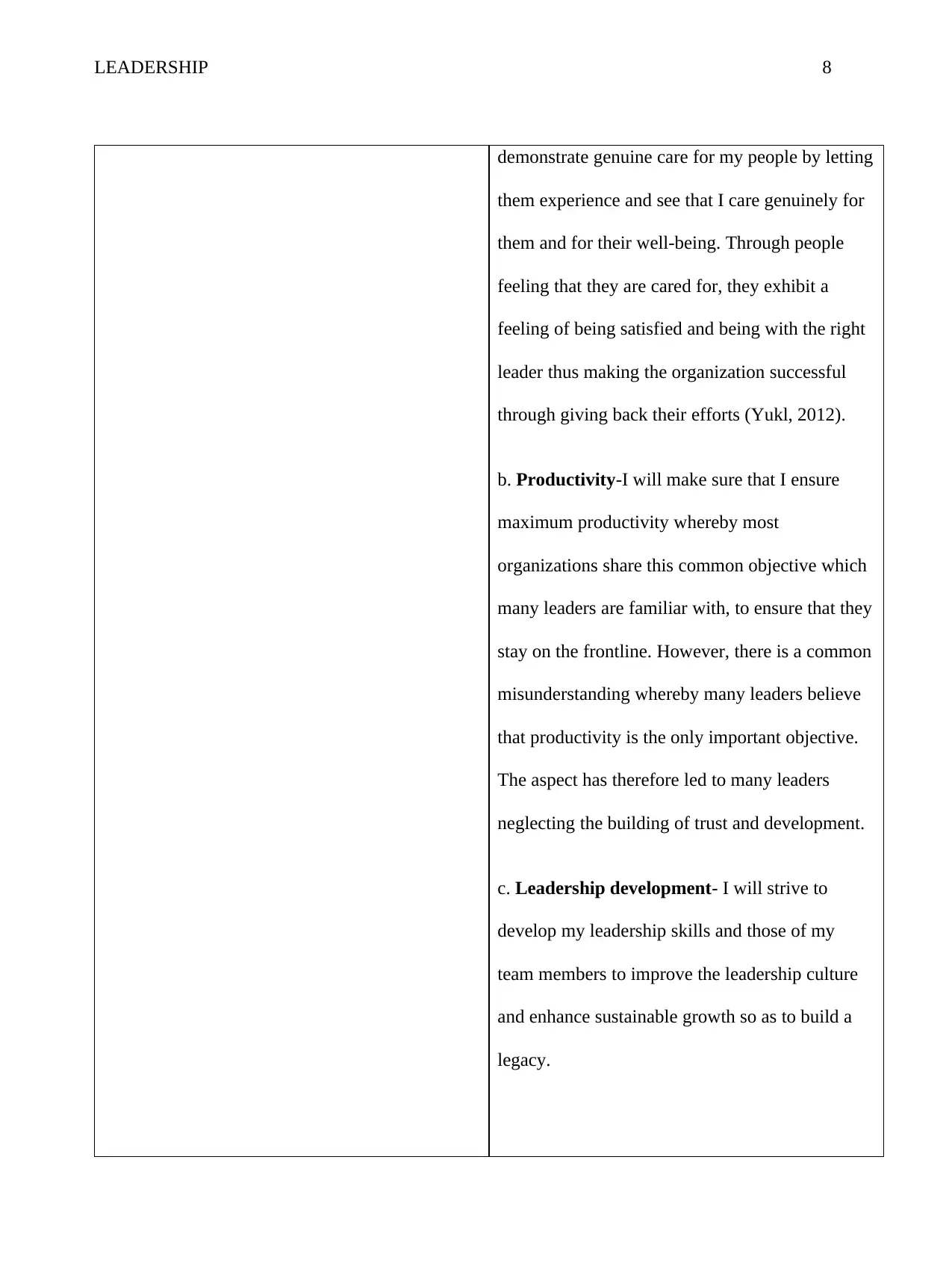
LEADERSHIP 8
demonstrate genuine care for my people by letting
them experience and see that I care genuinely for
them and for their well-being. Through people
feeling that they are cared for, they exhibit a
feeling of being satisfied and being with the right
leader thus making the organization successful
through giving back their efforts (Yukl, 2012).
b. Productivity-I will make sure that I ensure
maximum productivity whereby most
organizations share this common objective which
many leaders are familiar with, to ensure that they
stay on the frontline. However, there is a common
misunderstanding whereby many leaders believe
that productivity is the only important objective.
The aspect has therefore led to many leaders
neglecting the building of trust and development.
c. Leadership development- I will strive to
develop my leadership skills and those of my
team members to improve the leadership culture
and enhance sustainable growth so as to build a
legacy.
demonstrate genuine care for my people by letting
them experience and see that I care genuinely for
them and for their well-being. Through people
feeling that they are cared for, they exhibit a
feeling of being satisfied and being with the right
leader thus making the organization successful
through giving back their efforts (Yukl, 2012).
b. Productivity-I will make sure that I ensure
maximum productivity whereby most
organizations share this common objective which
many leaders are familiar with, to ensure that they
stay on the frontline. However, there is a common
misunderstanding whereby many leaders believe
that productivity is the only important objective.
The aspect has therefore led to many leaders
neglecting the building of trust and development.
c. Leadership development- I will strive to
develop my leadership skills and those of my
team members to improve the leadership culture
and enhance sustainable growth so as to build a
legacy.
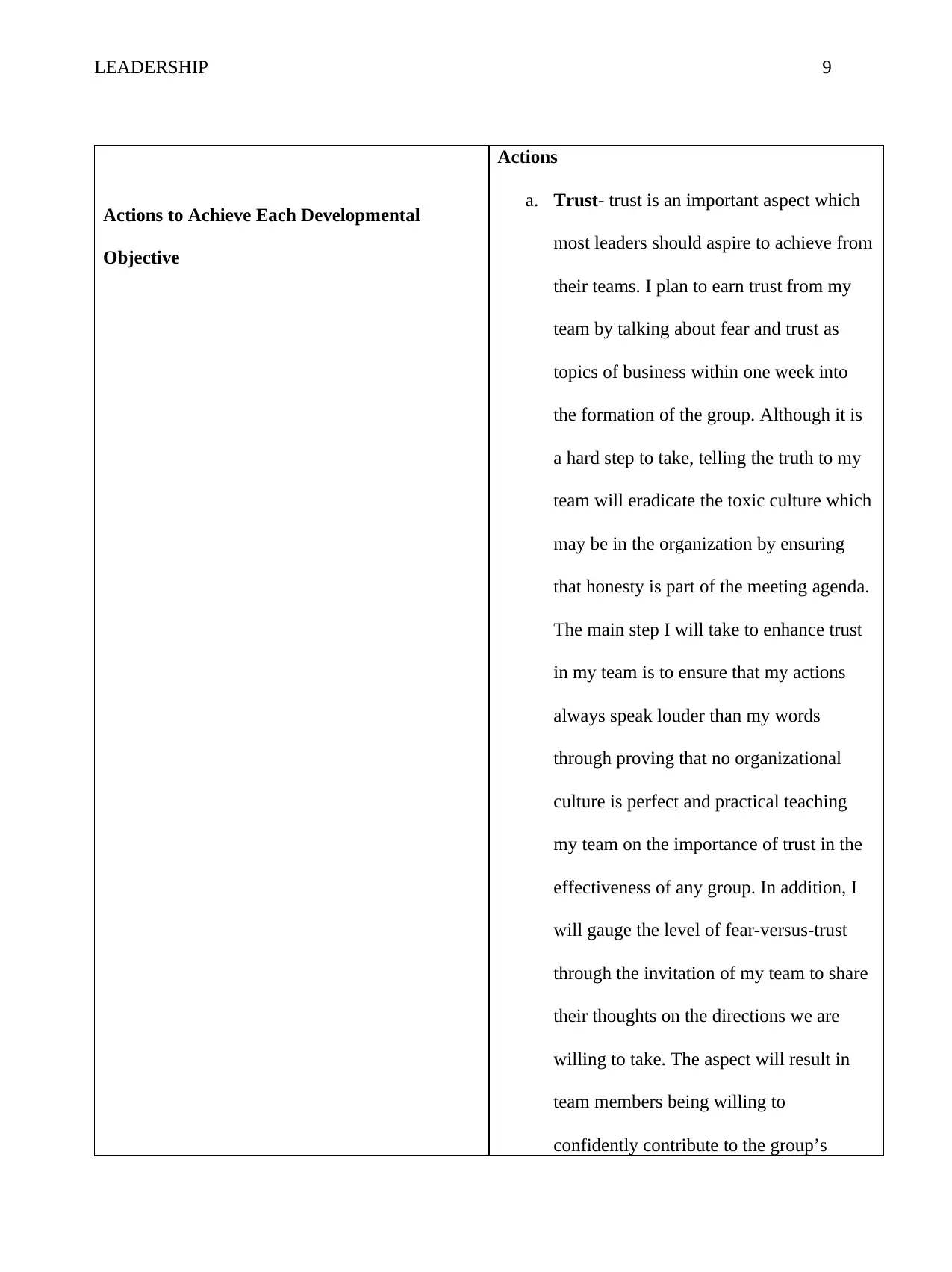
LEADERSHIP 9
Actions to Achieve Each Developmental
Objective
Actions
a. Trust- trust is an important aspect which
most leaders should aspire to achieve from
their teams. I plan to earn trust from my
team by talking about fear and trust as
topics of business within one week into
the formation of the group. Although it is
a hard step to take, telling the truth to my
team will eradicate the toxic culture which
may be in the organization by ensuring
that honesty is part of the meeting agenda.
The main step I will take to enhance trust
in my team is to ensure that my actions
always speak louder than my words
through proving that no organizational
culture is perfect and practical teaching
my team on the importance of trust in the
effectiveness of any group. In addition, I
will gauge the level of fear-versus-trust
through the invitation of my team to share
their thoughts on the directions we are
willing to take. The aspect will result in
team members being willing to
confidently contribute to the group’s
Actions to Achieve Each Developmental
Objective
Actions
a. Trust- trust is an important aspect which
most leaders should aspire to achieve from
their teams. I plan to earn trust from my
team by talking about fear and trust as
topics of business within one week into
the formation of the group. Although it is
a hard step to take, telling the truth to my
team will eradicate the toxic culture which
may be in the organization by ensuring
that honesty is part of the meeting agenda.
The main step I will take to enhance trust
in my team is to ensure that my actions
always speak louder than my words
through proving that no organizational
culture is perfect and practical teaching
my team on the importance of trust in the
effectiveness of any group. In addition, I
will gauge the level of fear-versus-trust
through the invitation of my team to share
their thoughts on the directions we are
willing to take. The aspect will result in
team members being willing to
confidently contribute to the group’s
⊘ This is a preview!⊘
Do you want full access?
Subscribe today to unlock all pages.

Trusted by 1+ million students worldwide
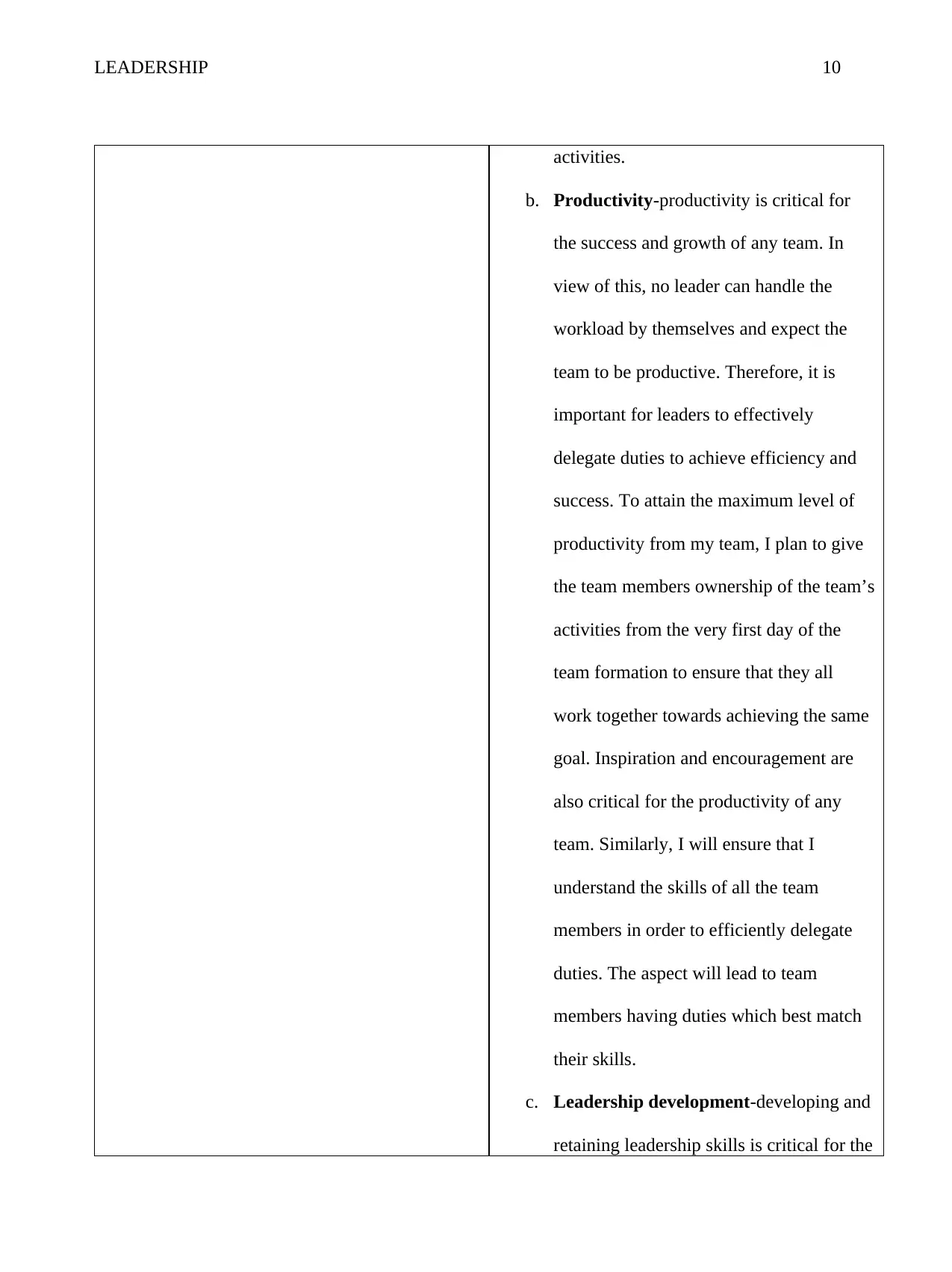
LEADERSHIP 10
activities.
b. Productivity-productivity is critical for
the success and growth of any team. In
view of this, no leader can handle the
workload by themselves and expect the
team to be productive. Therefore, it is
important for leaders to effectively
delegate duties to achieve efficiency and
success. To attain the maximum level of
productivity from my team, I plan to give
the team members ownership of the team’s
activities from the very first day of the
team formation to ensure that they all
work together towards achieving the same
goal. Inspiration and encouragement are
also critical for the productivity of any
team. Similarly, I will ensure that I
understand the skills of all the team
members in order to efficiently delegate
duties. The aspect will lead to team
members having duties which best match
their skills.
c. Leadership development-developing and
retaining leadership skills is critical for the
activities.
b. Productivity-productivity is critical for
the success and growth of any team. In
view of this, no leader can handle the
workload by themselves and expect the
team to be productive. Therefore, it is
important for leaders to effectively
delegate duties to achieve efficiency and
success. To attain the maximum level of
productivity from my team, I plan to give
the team members ownership of the team’s
activities from the very first day of the
team formation to ensure that they all
work together towards achieving the same
goal. Inspiration and encouragement are
also critical for the productivity of any
team. Similarly, I will ensure that I
understand the skills of all the team
members in order to efficiently delegate
duties. The aspect will lead to team
members having duties which best match
their skills.
c. Leadership development-developing and
retaining leadership skills is critical for the
Paraphrase This Document
Need a fresh take? Get an instant paraphrase of this document with our AI Paraphraser
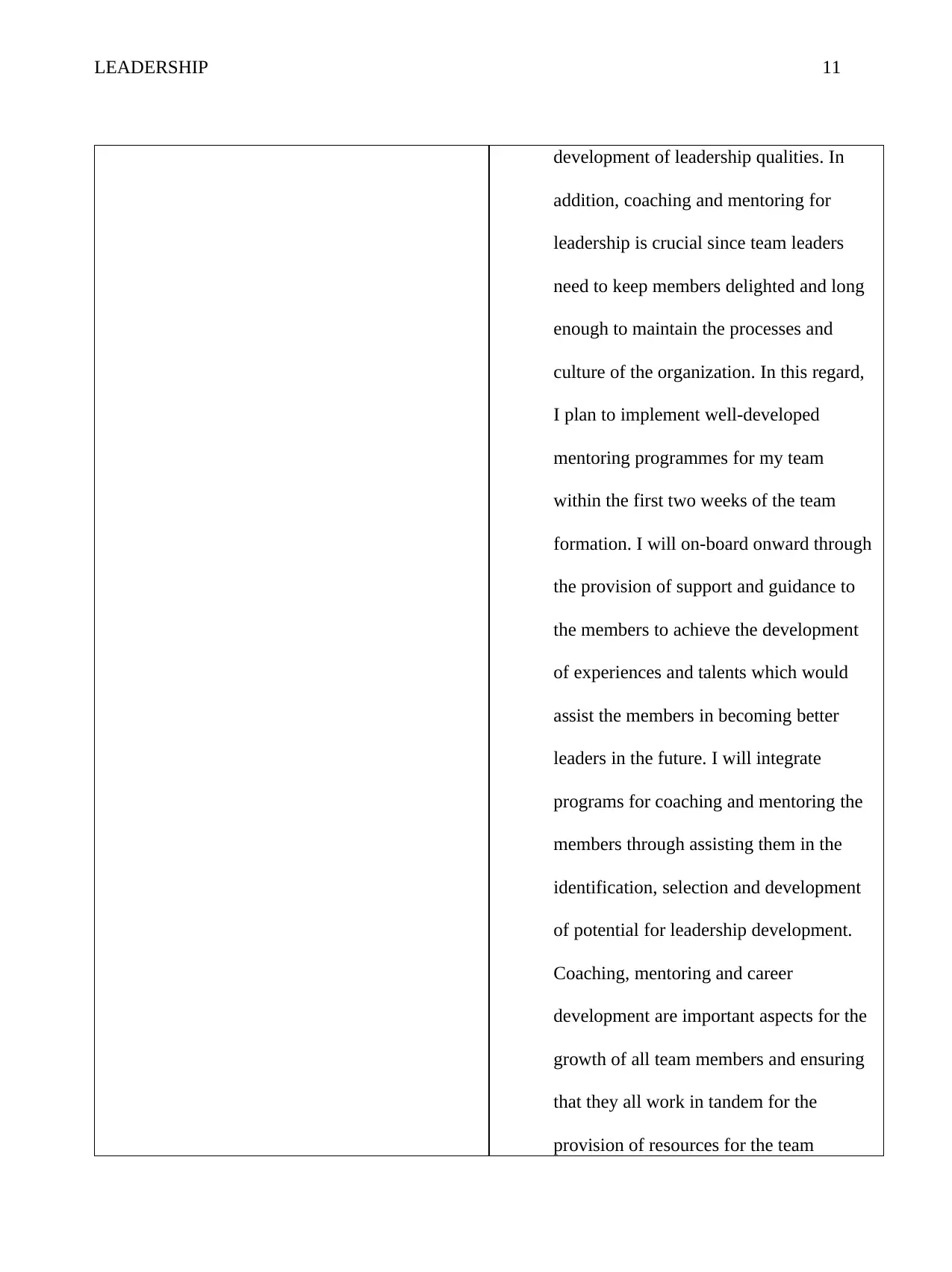
LEADERSHIP 11
development of leadership qualities. In
addition, coaching and mentoring for
leadership is crucial since team leaders
need to keep members delighted and long
enough to maintain the processes and
culture of the organization. In this regard,
I plan to implement well-developed
mentoring programmes for my team
within the first two weeks of the team
formation. I will on-board onward through
the provision of support and guidance to
the members to achieve the development
of experiences and talents which would
assist the members in becoming better
leaders in the future. I will integrate
programs for coaching and mentoring the
members through assisting them in the
identification, selection and development
of potential for leadership development.
Coaching, mentoring and career
development are important aspects for the
growth of all team members and ensuring
that they all work in tandem for the
provision of resources for the team
development of leadership qualities. In
addition, coaching and mentoring for
leadership is crucial since team leaders
need to keep members delighted and long
enough to maintain the processes and
culture of the organization. In this regard,
I plan to implement well-developed
mentoring programmes for my team
within the first two weeks of the team
formation. I will on-board onward through
the provision of support and guidance to
the members to achieve the development
of experiences and talents which would
assist the members in becoming better
leaders in the future. I will integrate
programs for coaching and mentoring the
members through assisting them in the
identification, selection and development
of potential for leadership development.
Coaching, mentoring and career
development are important aspects for the
growth of all team members and ensuring
that they all work in tandem for the
provision of resources for the team
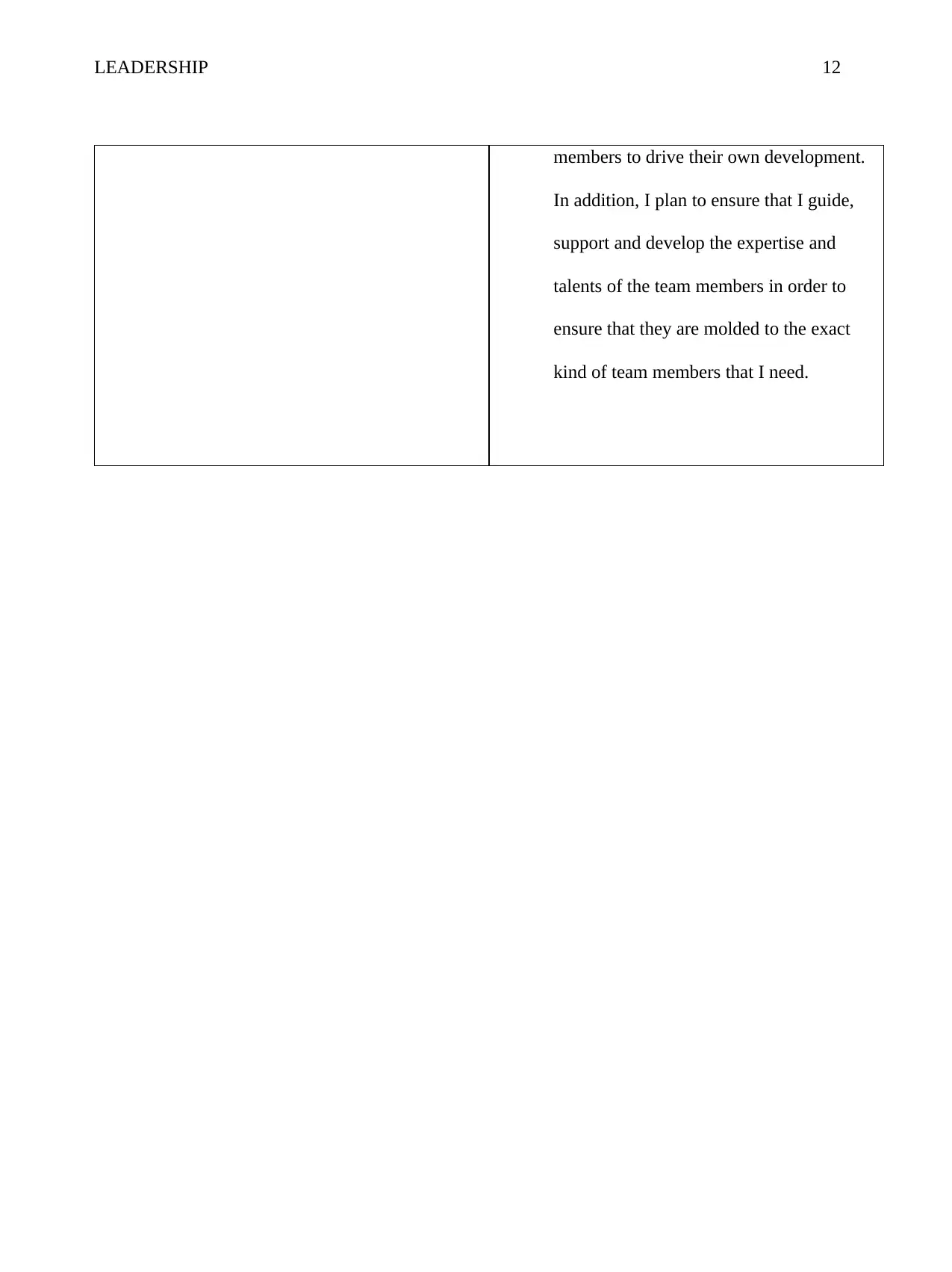
LEADERSHIP 12
members to drive their own development.
In addition, I plan to ensure that I guide,
support and develop the expertise and
talents of the team members in order to
ensure that they are molded to the exact
kind of team members that I need.
members to drive their own development.
In addition, I plan to ensure that I guide,
support and develop the expertise and
talents of the team members in order to
ensure that they are molded to the exact
kind of team members that I need.
⊘ This is a preview!⊘
Do you want full access?
Subscribe today to unlock all pages.

Trusted by 1+ million students worldwide
1 out of 19
Related Documents
Your All-in-One AI-Powered Toolkit for Academic Success.
+13062052269
info@desklib.com
Available 24*7 on WhatsApp / Email
![[object Object]](/_next/static/media/star-bottom.7253800d.svg)
Unlock your academic potential
Copyright © 2020–2025 A2Z Services. All Rights Reserved. Developed and managed by ZUCOL.



